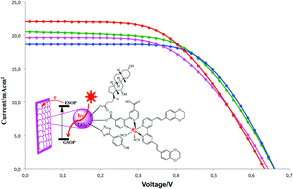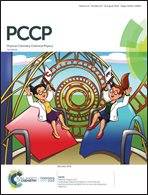Variation in hydrophobic chain length of co-adsorbents to improve dye-sensitized solar cell performance
Abstract
Three compounds based on the phenyltetrazole system, 5-(4-hydroxyphenyl)tetrazole (LTz-1), 5-(4-methoxyphenyl)tetrazole (LTz-2) and 5-(4-hexyloxyphenyl)tetrazole (LTz-3), were synthesized and characterized as co-adsorbents in dye-sensitized solar cells (DSSCs). The effects of hydrophobic chain length of the co-adsorbent and the effects of tetrazole anchoring group on the properties of DSSCs containing the previously reported dye HD-2 were compared with the benchmark deoxycholic acid (DCA). The charge-transfer resistance of the dye/TiO2 interface followed the order HD-2–DCA > HD-2–LTz-2 > HD-2–LTz-3 > HD-2–LTz-1. However, the Voc of the dye HD-2 with co-adsorbent DCA was 0.66 V, for the dye HD-2 with co-adsorbent LTz-1, it was 0.70 V, for the dye HD-2 with co-adsorbent LTz-2, it was 0.68 V and for the dye HD-2 with co-adsorbent LTz-3, it was 0.67 V. Co-adsorbents LTz-1, LTz-2 and LTz-3 achieved a mean solar-to-power conversion efficiency (%η), for the three devices, of 8.29, 7.63 and 8.49, respectively, compared to 7.76 for DCA under the same experimental device conditions. For the LTz-3 co-adsorbent, the results can be attributed to the repellent effect of the long alkyl chain. For LTz-1 and LTz-2 co-adsorbents, it is possible that the more compact layer formed improves electron-injection efficiency into TiO2.



 Please wait while we load your content...
Please wait while we load your content...